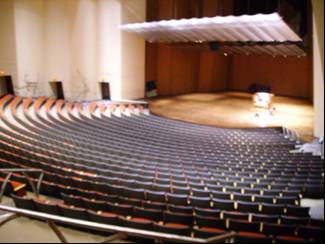 |
"That is a very good question, Mr. Piano. Each hall has its own acoustical characteristics, or way we sound. Take a good look around at my walls and ceiling. What do you see?" "Oh, look!" said the the violin in an excited voice. "Most rooms have four walls, but here...and, and the ceiling... Why are there all those curved panels?" |
 |
"Ah, yes. You do see! There are many walls in a concert hall and if you look closely you will notice that they are slightly curved and they don't go straight up to the ceiling, but rise at an angle. And those curved panels in the ceiling are called clouds. And the ones over the stage can even move up and down. Do you know why a concert hall is built with all these interesting walls and ceilings? |
"Is it because they want the room to look artistic?" asked the violin. "Oh, I know," said the piano. "It's because all those walls and ceiling tiles make the room sound better." "That's right," said Mr. SCFA. "When sound waves hit a wall, they are reflected back into the room. This creates what is called reverberation, or a kind of short echo. In normal rooms as the reflected sound waves mix with the sound waves coming from the stage, there can be places where the sound is especially loud or very soft. When this happens, we say there are live or dead spots in the room. And if you are listening to a concert, you certainly don't want to be in a dead spot. With all curved walls and ceilings, the sound waves mix nicely and everyone can enjoy the music that comes to their ears." "Wow!" said the little violin. "I didn't realize that the concert hall could make so much difference in how an orchestra would sound. Thank you for telling me about yourself, Mr. SCFA. But, Mr. Piano, I remember you were about to introduce me to the conductor. Who will be conducting this concert and what music has he chosen for us to play?" |
|